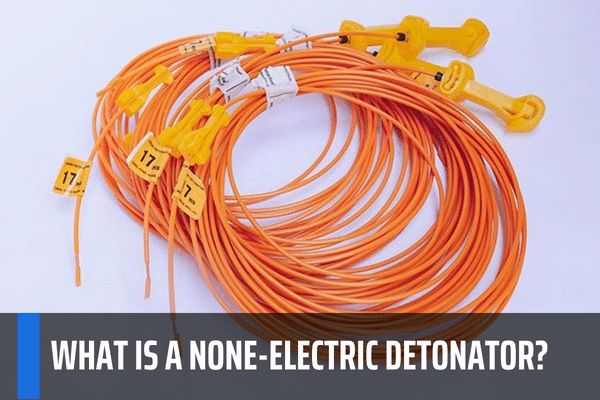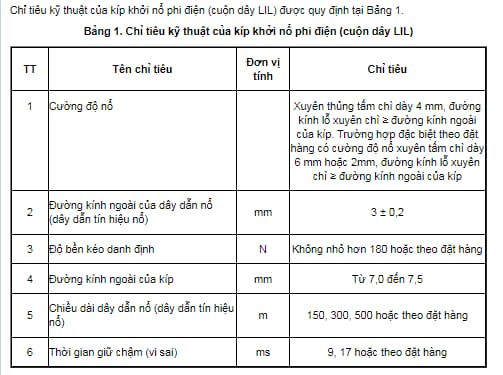What is a None-electric Detonator? What is the technical regulation of None-electric Detonator in Vietnam?
- Vietnam: What is a None-electric Detonator?
- What is the technical regulation of None-electric Detonator in Vietnam?
- What is the device and instrument to determine the explosive strength of the non-electric detonator in Vietnam?
- Vietnam: How to conduct a None-electric Detonator test?
- What is the regulation on management of None-electric Detonators (LIL coils) in Vietnam?
Vietnam: What is a None-electric Detonator?
Pursuant to subsection 3, Section I, Vietnam National Technical Regulation QCVN 12-8:2022/BCT on safety of industrial explosive materials - None-electric Detonator (LIL coil) defines None-electric Detonator as follows:
Non-electric detonator: A type of non-electric detonator (which has been tested for shock resistance before being attached to the detonation lead) attached to the detonation lead with a length of not less than 100 m to ensure a safe distance about air waves for explosive field detonators.

What is a None-electric Detonator? What is the technical regulation of None-electric Detonator in Vietnam? (Image from the Internet)
What is the technical regulation of None-electric Detonator in Vietnam?
Pursuant to subsection 5, Section II, Vietnam National Technical Regulation QCVN 12-8:2022/BCT on safety of industrial explosive materials - None-electric Detonator (LIL Coil) stipulates the technical regulation of None-electric Detonator as follows:

What is the device and instrument to determine the explosive strength of the non-electric detonator in Vietnam?
Pursuant to subsection 7 Section II of Vietnam National Technical Regulation QCVN 12-8:2022/BCT on safety of industrial explosive materials - None-electric Detonator (LIL Coil) stipulates equipment and tools to determine the explosive strength of a None-electric Detonator include:
- Specialized explosive strength testing equipment: See figure 1, point 5.1, TCVN 7460:2005;
- Round lead plate is made by casting method, then cold working, the size of lead plate is as follows: diameter 30 mm ± 1 mm, thickness 4 mm ± 0.1 mm (with explosive strength No. 6) or 6 mm ± 0.1 mm (with burst strength No. 8) or 2 mm ± 0.1 mm (with burst strength No. 4) as appropriate to order with different strengths. Lead used for casting lead sheets must meet the following quality criteria: Lead content is not less than 99.5%, impurities are not more than 0.5%;
- The igniter is used to ignite the explosive conductor.
Vietnam: How to conduct a None-electric Detonator test?
Pursuant to subsection 7 Section II of Vietnam National Technical Regulation QCVN 12-8:2022/BCT on safety of industrial explosive materials - None-electric Detonator (LIL Coil) stipulates how to conduct detonator test None-electric Detonator as follows:
- Number of test samples: 05 detonators used to install None-electric Detonators;
- Place the lead plate firmly in the position specified in the dedicated explosive strength tester. Place the fuse vertically, the bottom of the fuse is in contact with the center of the lead plate. Use a locator to hold the fuse firmly and stably, make sure the fuse and lead plate do not move before starting the detonation;
Install the door to protect the test equipment. Then proceed to connect the fuse to the igniter used to ignite the explosive conductor;
- Detonate the detonator with the igniter used to ignite the detonation wire. After detonating, wait 2 min to check the condition of the test piece and the lead plate;
- Carry out the test as above, in turn, the number of crews to be tested.
What is the regulation on management of None-electric Detonators (LIL coils) in Vietnam?
Pursuant to subsection 8 Section III Vietnam National Technical Regulation QCVN 12-8:2022/BCT on safety of industrial explosive materials - None-electric Detonator (LIL Coil) stipulating on the management of None-electric Detonator (LIL coil) as follows:
8. Regulations on management
8.1. None-electric Detonators (LIL coils) must declare conformity with technical regulations in Article 5 of this Technical Regulation, affix the conformity mark (CR mark) and label goods before being circulated on the market. school.
8.2. Domestic-made None-electric Detonators (LIL coils) must make the announcement of conformity according to the provisions of Circular No. 28/2012/TT-BKHCN dated December 12, 2012 of the Minister of Science and Technology. regulations on standard-conformity announcement, regulation-conformity announcement and methods of assessing conformity with standards and technical regulations (hereinafter abbreviated as Circular No. 28/2012/TT-BKHCN), Circular No. 02/2017/TT-BKHCN dated March 31, 2017 by the Minister of Science and Technology amending and supplementing a number of articles of the Minister's Circular No. 28/2012/TT-BKHCN dated December 12, 2012 The Ministry of Science and Technology stipulates on announcement of standard conformity, announcement of regulation conformity and methods of assessment of conformity with standards and technical regulations (hereinafter referred to as Circular No. 02/2017/TT-BKHCN for short) ) and Circular No. 06/2020/TT-BKHCN dated December 10, 2020 of the Minister of Science and Technology detailing and implementing measures for a number of articles of Decree No. 132/2008/ND-CP dated December 10, 2020. December 31, 2008, Circular No. 36/2019/TT-BCT dated 29 November 2019 of the Minister of Industry and Trade regulating the quality management of products and goods under the management responsibility of the Ministry of Industry and Trade (hereinafter abbreviated as Circular No. 36/2019/TT-BCT), Decree No. No. 154/2018/ND-CP dated November 9, 2018 and Decree No. 119/2017/ND-CP dated November 1, 2017 of the Government (hereinafter referred to as Circular No. 06/2020/TT-BKHCN) ).
8.3. Imported None-electric Detonators (LIL coils) must undergo state inspection of the quality of imported goods in accordance with the provisions of the Minister's Circular No. 36/2019/TT-BCT dated November 29, 2019 Industry and Trade regulates the quality management of products and goods under the management responsibility of the Ministry of Industry and Trade (hereinafter referred to as Circular No. 36/2019/TT-BCT).
Accordingly, None-electric Detonators (LIL coils) must declare conformity with technical regulations in Article 5 of this Technical Regulation, affix the conformity mark (CR mark) and label goods.
LawNet